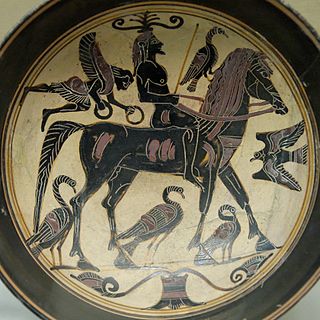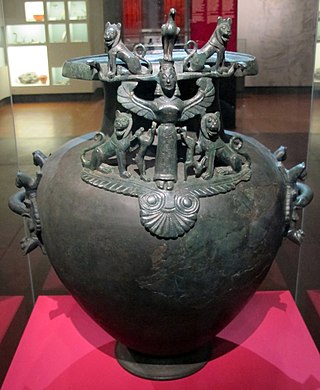This is an alphabetical index of articles related to painting.

Pottery, due to its relative durability, comprises a large part of the archaeological record of ancient Greece, and since there is so much of it, it has exerted a disproportionately large influence on our understanding of Greek society. The shards of pots discarded or buried in the 1st millennium BC are still the best guide available to understand the customary life and mind of the ancient Greeks. There were several vessels produced locally for everyday and kitchen use, yet finer pottery from regions such as Attica was imported by other civilizations throughout the Mediterranean, such as the Etruscans in Italy. There were a multitude of specific regional varieties, such as the South Italian ancient Greek pottery.

Black-figure pottery painting, also known as the black-figure style or black-figure ceramic, is one of the styles of painting on antique Greek vases. It was especially common between the 7th and 5th centuries BCE, although there are specimens dating as late as the 2nd century BCE. Stylistically it can be distinguished from the preceding orientalizing period and the subsequent red-figure pottery style.

Nikosthenes was a potter of Greek black- and red-figure pottery in the time window 550–510 BC. He signed as the potter on over 120 black-figure vases, but only nine red-figure. Most of his vases were painted by someone else, called Painter N. Beazley considers the painting "slovenly and dissolute;" that is, not of high quality. In addition, he is thought to have worked with the painters Anakles, Oltos, Lydos and Epiktetos. Six's technique is believed to have been invented in Nikosthenes' workshop, possibly by Nikosthenes himself, around 530 BC. He is considered transitional between black-figure and red-figure pottery.

Andokides was an ancient Athenian vase painter, active from approximately 530 to 515 B.C. His work is unsigned and his true name unknown. He was identified as a unique artistic personality through stylistic traits found in common among several paintings. This corpus was then attributed by John D. Beazley to the Andokides Painter, a name derived from the potter Andokides, whose signature appears on several of the vases bearing the painter's work. He is often credited with being the originator of the red-figure vase painting technique. To be sure, he is certainly one of the earliest painters to work in the style. In total, fourteen amphorae and two cups are attributed to his hand. Six of the amphorae are "bilingual", meaning they display both red-figure and black-figure scenes.

Hermonax was a Greek vase painter working in the red-figure style. He painted between c. 470 and 440 BC in Athens. Ten vases signed with the phrase "Hermonax has painted it" survive, mainly stamnoi and lekythoi. He is generally a painter of large pots, though some cups survive.

John Percival Droop was a British classical archaeologist of Dutch descent.

The Heidelberg Painter was an Attic vase painter of the black-figure style, active between about 575 and 555 BC. He is considered one of the most important painters of Siana cups. Along with the C Painter, he is considered the main representative of his style. Generally, the Heidelberg Painter is regarded as the more accomplished artist of the two, although his work did not reach the same breadth of scope. In contrast to many of his contemporaries, he placed special emphasis on the depiction of human figures, at which he was very adept. His figures are very detailed, but often drawn rather sloppily. His early works resemble those of the Comast Group, the later ones those of the Amasis Painter.

The Goltyr Painter was an Attic vase painter of the black-figure style. He was active in the second quarter of the sixth century BC. He is well known for his work on Tyrrhenian amphorae. He mostly painted animals, often with rather bulbous heads.
Phrynos was a Greek potter, active in Athens, circa 560–545 BC. He is one of the Little masters. Three signed lip cups by him are known:

A Siana cup is a type of Attic cup decorated in the black-figure technique. They are named after one of their find locations, the Necropolis of the ancient city of Siana on Rhodes. During the second quarter of the 6th century BC, Siana cups were the predominant cup shape in Athens. The shape remained popular later and was still being produced in large quantities during the era of the Little-master cups.

The Phrynos Painter was an Attic black-figure vase painter, active in Athens between c. 560 and 545 BC. He was allocated the conventional name "Phrynos Painter" after the potter Phrynos, as he had painted three cups signed by the latter:

Laconian vase painting is a regional style of Greek vase painting, produced in Laconia, the region of Sparta, primarily in the 6th century BC.

The Arkesilas Painter was a Laconian vase painter active around 560 BC. He is considered one of the five great vase painters of Sparta.

The Rider Painter was a Laconian vase painter active between 560 and 530 BC. He is considered one of the five great vase painters of Sparta.

The Arkesilas Cup is a kylix by the Laconian vase painter known as the Arkesilas Painter, whose name vase it is. It depicts, and is thus named after, Arkesilaos II, king of Kyrene and is dated to about 565–560 BC.
In Greek mythology, Tiasa was a Naiad nymph of a river near Amyclae, Sparta. She was a Laconian princess as the daughter of King Eurotas and Cleta, and thus sister of Sparta.
In 2019, the top 50 Dutch law firms had around 4,476 attorneys and the top 30 law firms had around 183 notaries and 527 candidate notaries. According to the Chambers and Partners legal directory, the top five law firms in the Netherlands are Allen & Overy Netherlands, De Brauw Blackstone Westbroek, Houthoff, Loyens & Loeff and Stibbe. Every year advocatie.nl publishes a list of the 50 biggest law firms in headcount.

Grächwil is a hamlet of the municipality of Meikirch in the Swiss canton of Bern. A number of Hallstatt period artefacts have been found in Grächwil, including an imported bronze vessel known as the 'Grächwil Hydria', found in the princely tomb of a Celtic chieftain in 1851. The hydria is thought to originate from Laconia in Greece and its production is dated to ca. 600 BC, or the first half of the 6th century BC. The burial is dated to c. 500 BC.













